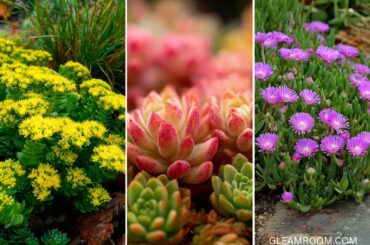You walk through your garden, feeling proud of the blooms and the greenery, but something tugs at you. The edges feel messy. The plants are thriving, yes, but the whole space feels like it’s spilling out without boundaries. You pause and think, It just needs a little definition.
That’s the quiet power of a garden border. It doesn’t scream for attention, it simply shapes the scene. A soft curve of river stones. A crisp line of bricks. Low hedges, timber edges, even recycled materials with a bit of charm. The right border brings order to the wild, letting your plants shine while giving the space a sense of purpose.
Whether you love a polished, formal look or something more relaxed and natural, a garden border helps you frame your space, just like a picture. It guides the eye. It finishes the thought.
These 16 Garden Borders That Look Great With Bark are here to inspire just that: simple, beautiful ways to elevate your garden without overwhelming it. Because sometimes, all a garden needs is a strong edge to feel complete.
1. Woodland Bark Pathway with Iris Border

Bark mulch adds a grounded, natural feel to this woodland garden path. Tall irises in deep violet bloom along the edge, softening the line between walkway and forest floor. Lush ferns peek through for extra texture and charm. Surrounded by slender birch trees, the border feels both serene and wild.
Tip: Use bark mulch to define paths between perennial beds. It blends effortlessly into shaded or wooded gardens.
2. Natural Log Border with Succulents and Bark

A weathered log blends effortlessly into this drought-friendly border, framed by bark mulch and clusters of low-growing succulents. Large rocks anchor the space, adding structure without breaking the relaxed, rustic feel. Golden afternoon light adds warmth to the textures around it.
Tip: Use bark mulch around succulents to retain moisture and contrast their cool tones with rich, earthy texture.
3. Rustic Timber Border Beneath Shade-Loving Hostas

A weathered timber edge lines this shady garden bed, separating bark mulch from a gravel path. Thick clusters of hostas in lime, emerald, and variegated tones spill slightly over the border, softening the edge with lush foliage. The tree trunk adds grounding character and anchors the border visually.
Tip: Lay bark mulch beneath large-leaf plants to help suppress weeds and retain soil moisture in shady spots.
4. Layered Stone Border Around a Mature Tree

Natural stacked stone creates a tidy raised border around this massive tree, giving structure to the lush bed of hostas and groundcovers. A mix of rich bark mulch and soil keeps things neat while helping moisture stay put beneath the leafy shade. The white picket fence in the backdrop adds classic charm.
Tip: Use bark mulch in raised beds like this to reduce erosion and keep your plants well-fed and hydrated.
5. River Rock and Bark Border in a Water-Wise Front Yard

Flat stone pavers wind through a front yard filled with native grasses and low-water plants. River rocks edge each step, creating clean lines and natural flow. Bark mulch around the base of taller plants keeps the soil cool and neat. The mix of texture and color feels calm and earthy.
Tip: Use bark mulch in xeriscapes to reduce watering and tie greenery together visually.
6. Bark-Lined Shade Path with Lush Hosta Border

A winding bark path flows gently through layers of hostas and ferns beneath a towering tree. The rich texture of bark mulch blends into the woodland-style garden, holding moisture and keeping weeds at bay. Shades of green and blue surround the walkway, drawing the eye toward the cozy front porch beyond.
Tip: Lay bark mulch in shaded paths to keep the soil cool and soften the garden’s look.
7. Bark Border with Wildflowers and Tall Foxgloves

Amber foxgloves and purple coneflowers bring a natural burst of color to this bark-lined garden bed. The warm mulch helps define the space while holding moisture around the roots. Nestled under mature pine trees, this border feels loose yet well-framed—great for a low-maintenance, pollinator-friendly space.
Tip: Add bark mulch to flower-heavy borders to reduce watering and keep the focus on the blooms.
8. Raised Wooden Border with Bark and Gravel Accents
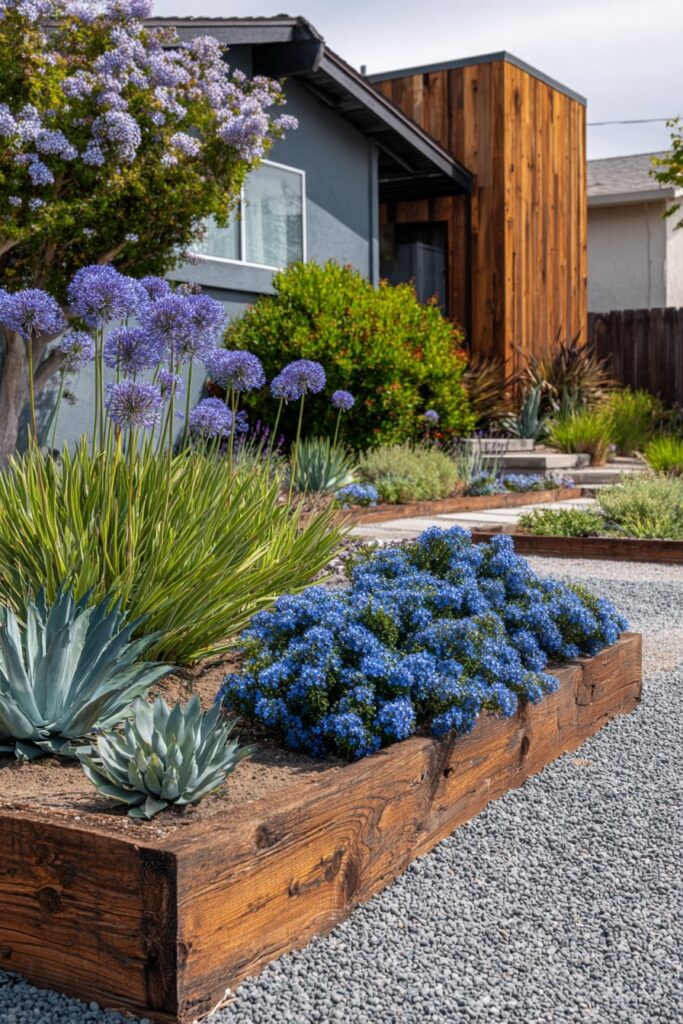
Bold timber edging shapes these raised beds, packed with water-wise plants like agave, agapanthus, and blue-flowering groundcover. Bark mulch tucks around the base of each plant, keeping the soil in place and tying the textures together. Soft gravel paths between beds balance the warmth of the wood with a clean, modern touch.
Tip: Use bark mulch inside raised borders to support healthy root growth and keep things looking polished.
9. Cottage-Style Border with Bark and Delphiniums

Tall blue and white delphiniums bring soft color and structure to this front garden bed. Low shrubs and seasonal flowers fill in around the base, all held neatly by a layer of bark mulch that keeps things tidy and moist. The warm tones of the mulch echo the wooden shutters nearby, tying the space together.
Tip: Use bark mulch in cottage borders to highlight tall blooms and reduce soil splash on leaves.
10. Wooden Raised Border with Hydrangeas and Bark Base

Sturdy wooden boxes frame a lush planting of white hydrangeas and tidy boxwoods. Beneath the foliage, a layer of bark mulch keeps things neat and nourished while adding rich contrast to the light gravel paths. The rustic wood adds warmth and ties into the soft green tones of the blooms.
Tip: Tuck bark mulch under flowering shrubs in raised beds to conserve moisture and reduce cleanup.
11. Free-Form Bark Border in a Cottage Garden

Blue delphiniums, white daisies, and lavender blooms fill this soft, untamed border with charm. A natural bark mulch path cuts through the wild mix, keeping the garden grounded while allowing room to wander. The cottage-style house tucked behind it all completes the storybook setting.
Tip: In loose cottage beds, use bark mulch to shape walking space and control moisture without disrupting the flow.
12. Crisp Wooden Raised Border with Bark and Hydrangeas
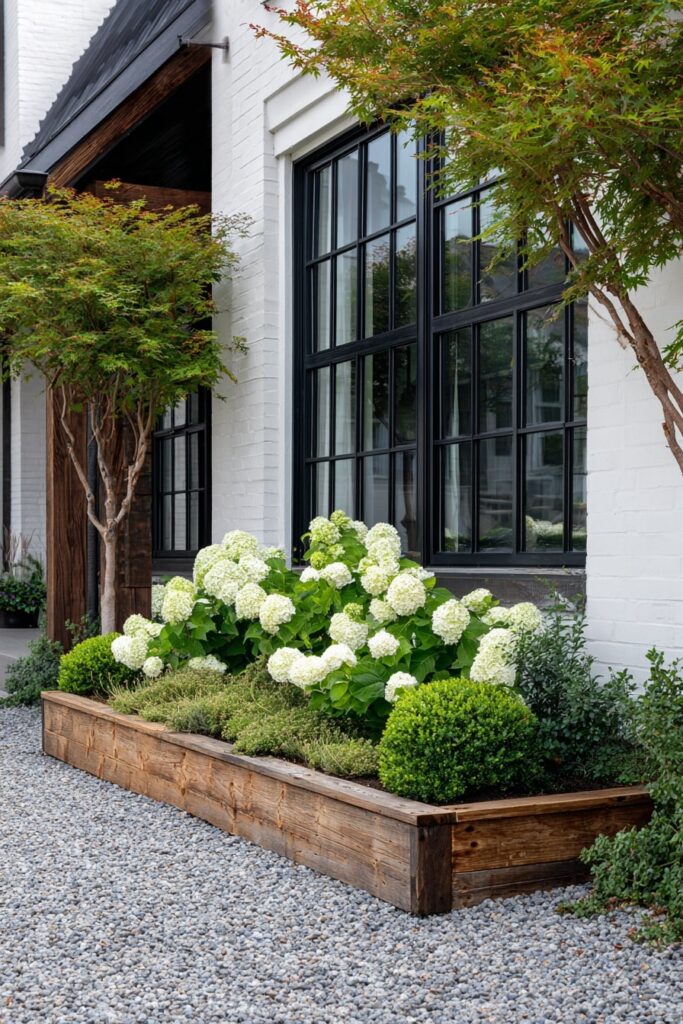
Simple wooden boards frame a compact raised bed filled with soft white hydrangeas and clipped boxwood. Bark mulch at the base keeps the planting clean while helping the roots stay cool in warm weather. Surrounded by fine gravel, this setup feels modern but grounded—just enough structure to highlight the blooms.
Tip: Add bark mulch in small raised beds to create contrast and keep soil temperature steady.
13. Clean Bark Border with Boxwood and Lilac

Bright green boxwood leaves stretch just above a rich layer of bark mulch, creating a crisp and tidy line along this garden bed. White lilacs peek softly in the background, adding scent and softness to the space. The bark keeps weeds out and moisture in while warming up the overall palette.
Tip: Use bark mulch under shrubs to create clean lines and lower your garden’s maintenance needs.
14. Oversized Wooden Border with Bark and Native Grasses
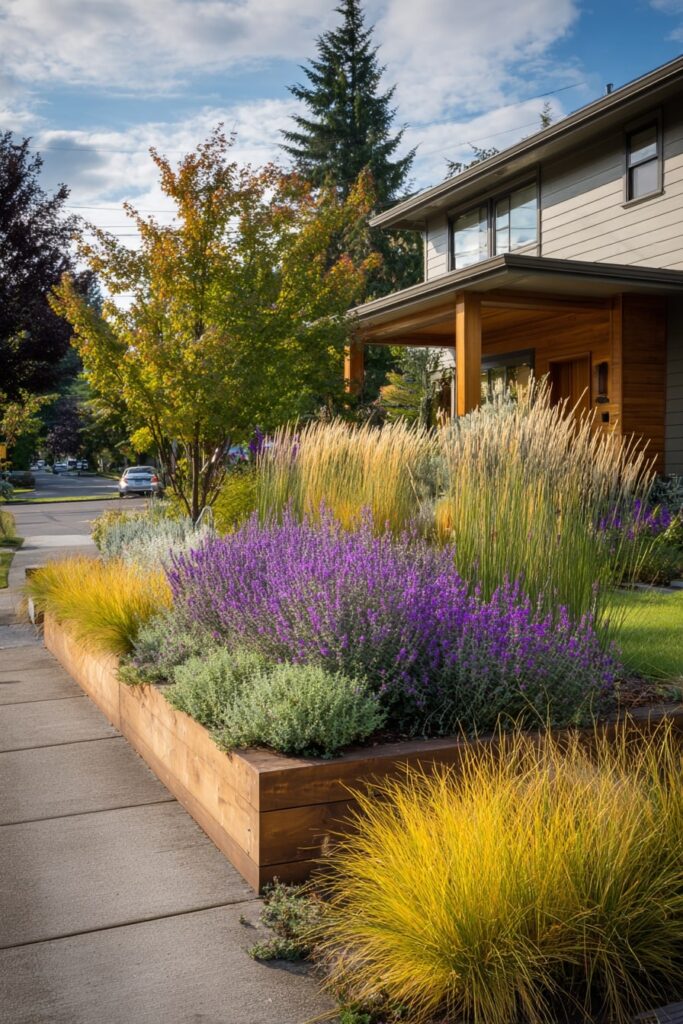
This modern front yard uses tall wooden edging to frame a raised bed filled with ornamental grasses and blooming purple sage. Bark mulch beneath the plants keeps weeds in check and adds a deep contrast to the warm tones of the wood. Everything flows neatly from the sidewalk to the porch, without feeling too strict.
Tip: In large beds, add bark mulch to tie plant layers together and help moisture stay where it’s needed.
15. Curved Rock Edge with Bold Black Bark Mulch
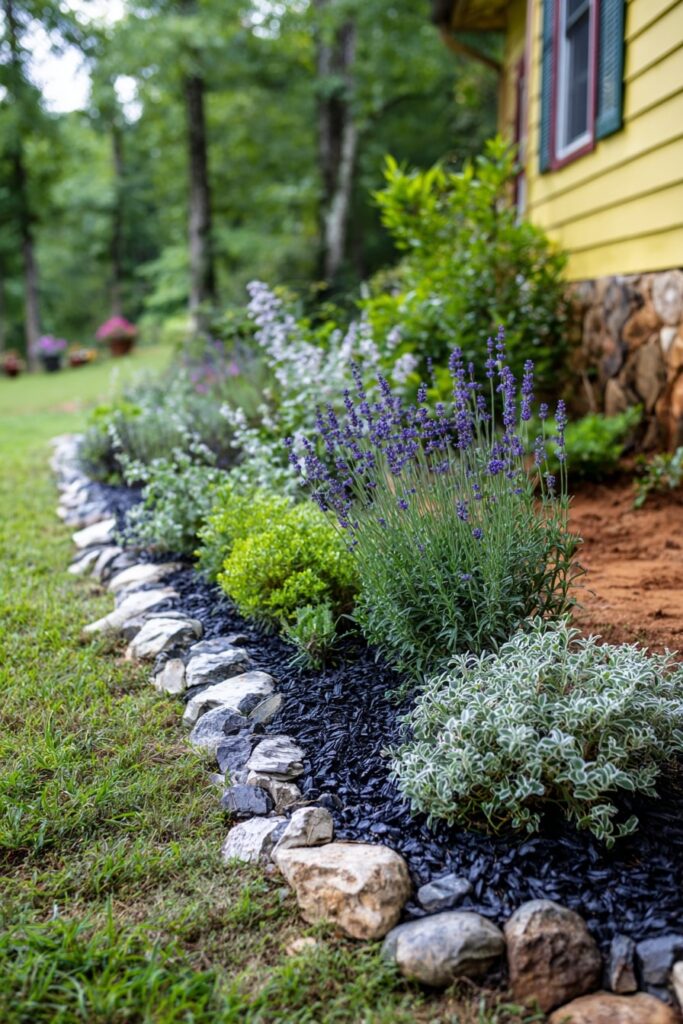
Rough stones form a casual yet defined border around this lively front bed. Black bark mulch makes the greenery and lavender pop while locking in moisture under the surface. The color contrast adds visual punch and makes each plant stand out in the morning light.
Tip: Use dark bark mulch with light stones to boost curb appeal and spotlight your plant choices.
16. Tropical Border with Bark Mulch and Smooth White Stones

Glossy leaves and lush ferns crowd this shady corner, grounded by a base of warm bark mulch and scattered white stones. The contrast between textures makes the greenery shine while helping the space feel balanced. A curved timber edge blends naturally into the plant mix, holding everything in place.
Tip: Use bark mulch in tropical borders to enhance contrast and support plant health in humid conditions.




